Introduction
In the rapidly evolving landscape of cloud computing, organizations are increasingly confronted with the imperative of managing their cloud expenditures effectively. Cloud cost optimization emerges as a vital strategy, enabling businesses to not only reduce unnecessary expenses but also to maximize the value derived from their cloud investments.
As decision-makers grapple with the complexities of cloud pricing models and strive for enhanced visibility over their spending, the necessity for a systematic approach to cost management becomes evident. This article delves into the essential components of cloud cost optimization, highlighting its key benefits, best practices, and the challenges organizations face in this critical arena.
By fostering a culture of financial accountability and leveraging strategic insights, companies can navigate the intricacies of cloud spending and position themselves for sustainable growth in an increasingly data-driven world.
Defining Cloud Cost Optimization: An Essential Overview
Optimizing expenses in the digital infrastructure is a strategic process aimed at efficiently managing expenditures related to online services while maximizing the cloud cost optimization benefits and enhancing their inherent value. This approach encompasses:
- A thorough analysis of usage patterns
- The identification of key cost drivers
- The implementation of targeted measures to enhance resource allocation
With a significant 82% of decision-makers citing managing expenditure on digital services as their primary challenge, it is evident that organizations are increasingly prioritizing this discipline.
As noted by Veeam, 'The virtual infrastructure plays a crucial role in today’s data protection strategy,' with half of surveyed businesses recognizing its vital role in contemporary data protection strategies, utilizing it for disaster recovery and workload migration. Moreover, as emphasized in the case study 'Data Storage Trends,' the digitization of life and the connectivity of devices are resulting in an exponential rise in data generation, requiring storage solutions. By participating in expense optimization, companies can leverage cloud cost optimization benefits to:
- Reduce the risk of overspending
- Improve their return on investment (ROI)
- Ensure that expenditures are aligned with overarching business objectives
This systematic method for financial management is essential for preserving operational efficiency and encouraging innovation, allowing entities to utilize online capabilities while enjoying cloud cost optimization benefits without facing excessive expenses. Additionally, for those looking to deepen their understanding of infrastructure management, the guide titled 'The Practitioner’s Guide to Scaling Infrastructure as Code' is available for download, providing further insights on transforming IaC management to scale securely, efficiently, and productively.
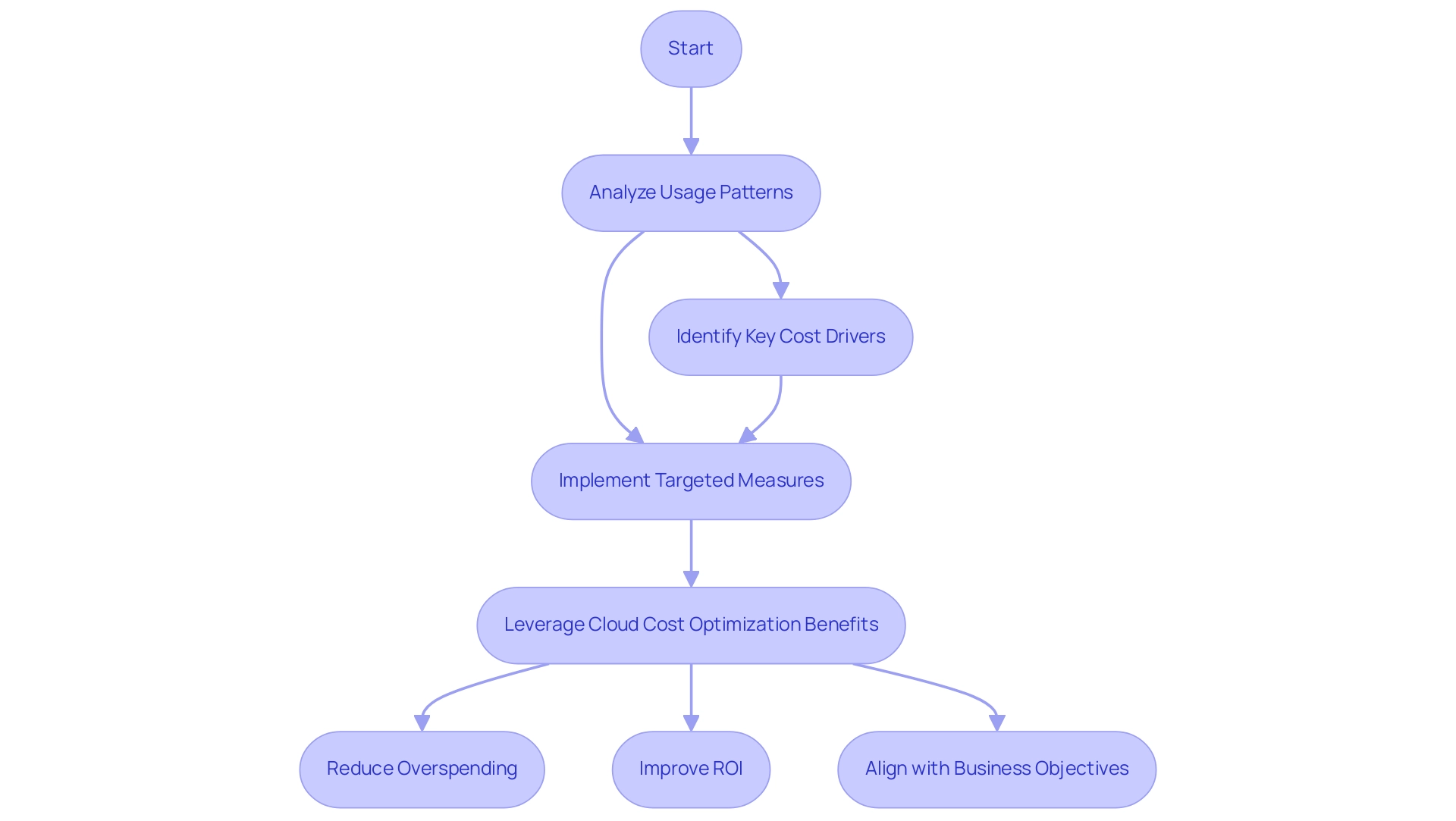
Key Benefits of Cloud Cost Optimization: Unlocking Savings and Efficiency
Executing efficient online expense optimization tactics offers multiple important benefits for companies:
-
Cost Savings: By pinpointing underutilized resources and optimizing expenditures, organizations can achieve cloud cost optimization benefits and significantly reduce unnecessary costs. For instance, Applause integrated CloudZero, resulting in a remarkable 23% decrease in their online infrastructure expenses. Additionally, with a Professional Account for teams of up to 5 individuals costing $959 USD per month, managing expenses effectively becomes crucial.
-
Improved Efficiency: Streamlining digital resource usage not only enhances performance but also provides cloud cost optimization benefits that boost overall productivity. Businesses that manage their online resources efficiently can expect to see operational improvements that translate into better service delivery and faster time-to-market. Enhanced visibility in a well-structured strategy for cloud cost optimization benefits promotes transparency in spending. This heightened visibility enables entities to make informed, data-driven financial choices that leverage cloud cost optimization benefits, aligning their expenditures with strategic business goals.
-
Improved Asset Distribution: Enhanced digital management enables entities to assign assets efficiently to high-priority initiatives. This ensures that technology investments are directly supporting critical business goals, enhancing overall operational alignment.
-
Scalability: Effective management of resources provides cloud cost optimization benefits by facilitating easier scaling of infrastructure in response to fluctuating business demands. This agility not only prevents unnecessary expenses but also allows entities to adjust quickly to market shifts.
In the context of changing digital environments, with forecasts that 50% of information will be stored online by 2025 and total global data reaching 200 zettabytes, and with 92% of entities employing a multicloud strategy, the need for strong digital expense optimization techniques is more urgent than ever.
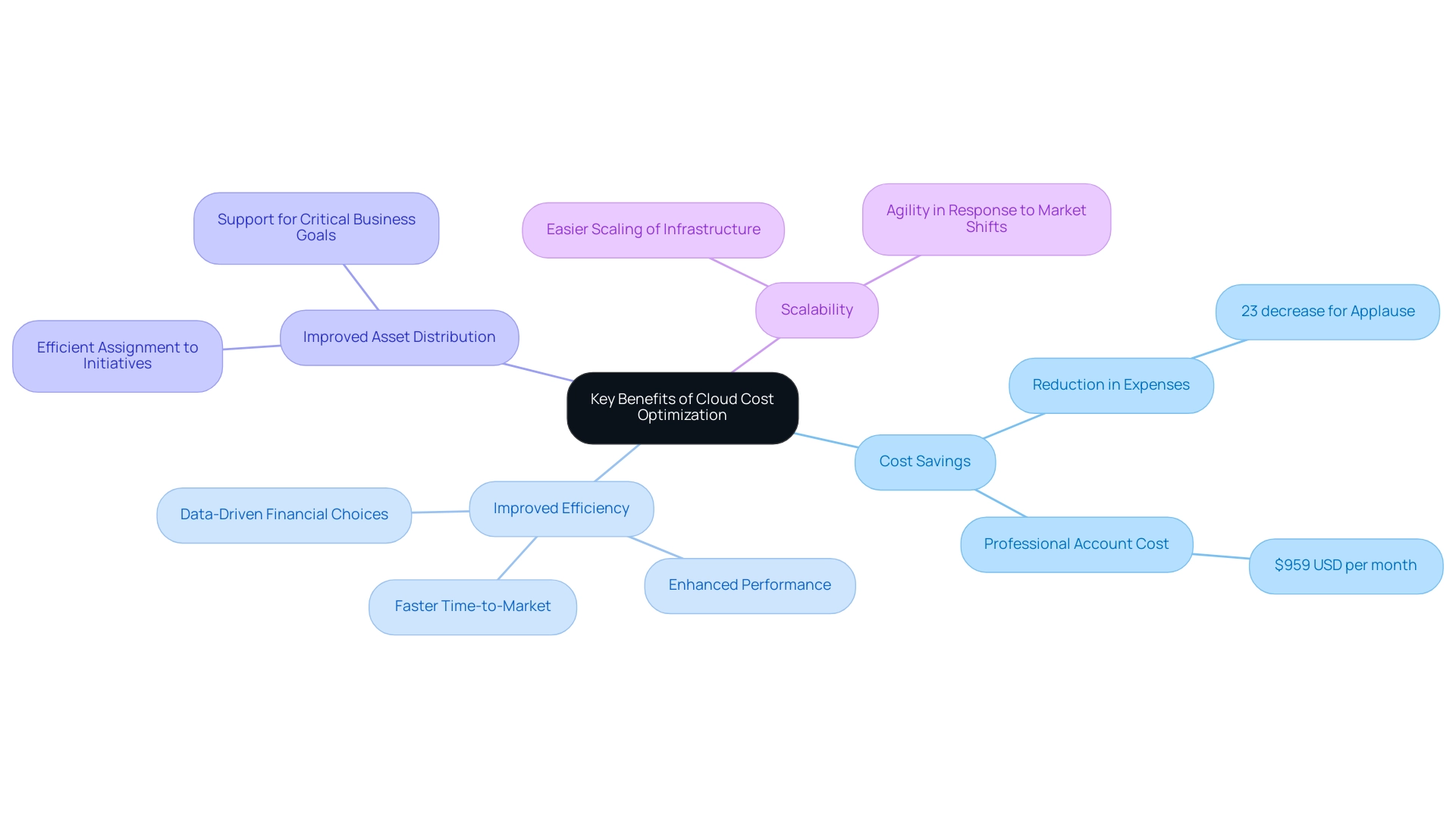
Best Practices for Effective Cloud Cost Optimization
To optimize expenses in the digital environment efficiently, entities should adopt the following best practices:
-
Regularly Monitor Resource Usage: Employ advanced monitoring tools that provide detailed insights into resource utilization. This proactive approach allows organizations to detect inefficiencies and adjust their strategies accordingly, resulting in cloud cost optimization benefits. Notably, many companies potentially spend millions of dollars every year on data transfer charges, underscoring the importance of effective monitoring.
-
Set Budgets and Alerts: Establish clear budgets for computing expenditures and configure alerts to notify relevant stakeholders when nearing financial limits. This practice not only fosters accountability but also aids in preventing unexpected overspending.
-
Implement Tagging Strategies: Effective tagging of assets enhances visibility into cloud expenditures, enabling the precise allocation of expenses to specific projects or teams. This strategic approach is crucial for understanding expenditures and highlights the cloud cost optimization benefits in optimizing management of assets.
-
Leverage Reserved Instances: For predictable workloads, utilizing reserved instances or savings plans can lead to substantial cost reductions. By committing to longer-term needs, organizations can take advantage of cloud cost optimization benefits to significantly reduce their overall expenses for resources.
-
Conduct Cost Reviews: Regular assessments of expenses and usage patterns are essential for identifying cloud cost optimization benefits and further optimization opportunities. A demonstration of this is clear in a case study centered on enhancing storage solutions, where entities that assessed their storage utilization and enacted lifecycle policies effectively moved data to less expensive storage tiers as it matured, reducing expenses over time. This illustrates the significance of ongoing assessment in managing expenses efficiently.
In 2024, effective management of expenditures is not merely a financial necessity; it also signifies a strategic benefit, particularly considering that Google holds an 11% market share and Alibaba 4% as of 2023. As Gartner emphasizes,
This technological approach enables businesses and individuals to scale, collaborate, and innovate at unprecedented levels, reshaping industries and revolutionizing the way we work and live.
By prioritizing these best practices, organizations can ensure they are not only managing expenses but also positioning themselves for future growth and efficiency.
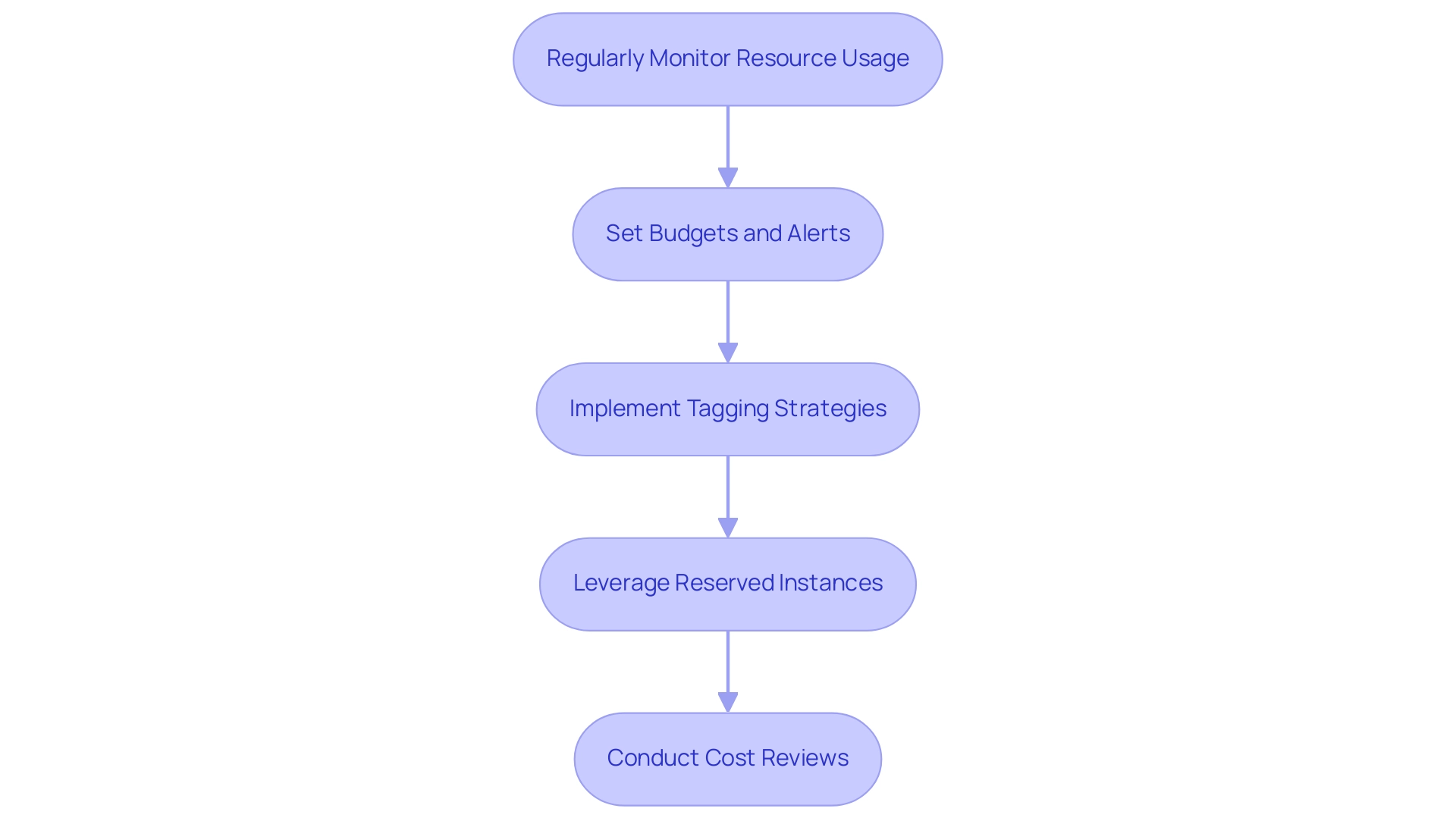
Navigating Challenges in Cloud Cost Optimization
Organizations often face significant hurdles in their pursuit of effective cloud cost optimization, including the following key challenges:
-
Complex Pricing Models: The multifaceted pricing structures of online services can be daunting. As emphasized by recent statistics, 49% of businesses utilizing online services struggle to manage their expenses, with a significant portion of this waste—54%—stemming from inadequate visibility into these intricate pricing structures. Furthermore, with Amazon Web Services holding a 32% market share, understanding these pricing models becomes crucial for effective cost management.
-
Lack of Visibility: Without robust monitoring tools, organizations may find it difficult to obtain clear insights into their computing expenses and usage patterns. This lack of transparency can hinder strategic financial planning and lead to overspending.
-
Cultural Resistance: Transitioning to a cost-conscious mindset often encounters pushback from teams that are accustomed to previous operational models. Building a culture focused on financial accountability requires careful management and communication.
-
Asset Expansion: The simplicity of provisioning online assets can result in asset expansion. Unused or underutilized assets can accumulate, significantly increasing expenses without providing value.
-
Inadequate Training: Many organizations lack sufficient training on online cost management tools and strategies. Investing in training and resources is essential to empower teams to effectively navigate these challenges and optimize spending.
As Mariusz Michalowski, Community Manager at Spacelift, noted, "Organizations must embrace automation and adopt open-source solutions to overcome these obstacles effectively." With 82% of cloud decision-makers identifying managing cloud spend as their primary challenge, addressing these areas is critical for achieving efficiency and realizing the cloud cost optimization benefits in cloud operations.
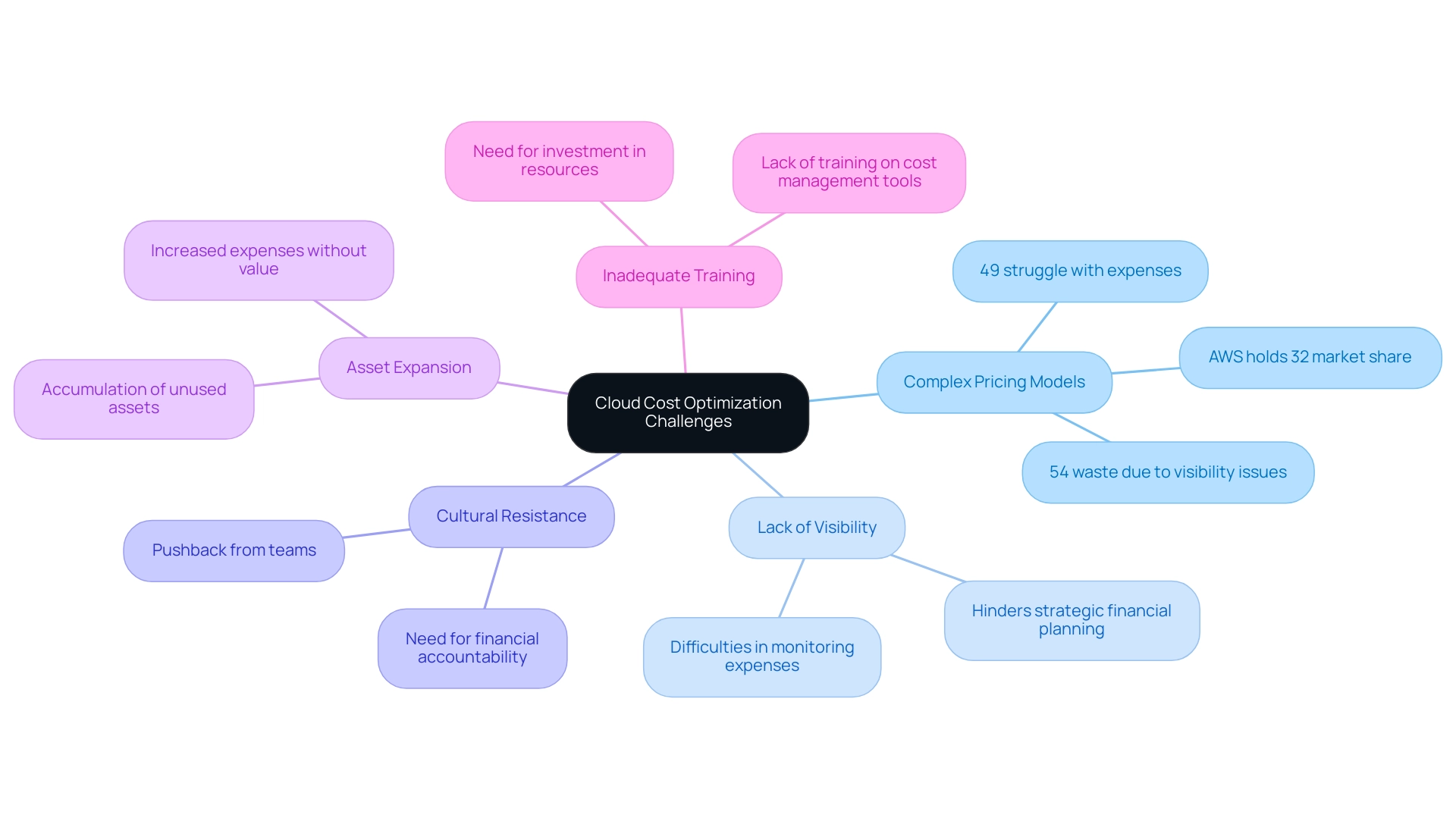
Cultivating a Cost-Conscious Culture for Sustainable Cloud Management
To cultivate a cost-conscious culture within a company, it is essential to implement the following strategies:
-
Leadership Buy-In: Leadership must actively endorse and champion cost-conscious practices throughout the entity. The effect of leadership backing cannot be exaggerated; studies show that organizations with strong leadership dedication experience a noticeable difference in asset management and overall expenditure efficiency.
-
Train Teams: Offering organized training sessions and thorough materials is essential for assisting teams in understanding the financial impacts of their usage. This education empowers employees to make informed decisions regarding resource allocation, ultimately leading to more responsible spending habits. As emphasized by research specialist Lionel Sujay Vailshery, while digital solutions promise savings, without adequate comprehension, the reality can frequently vary considerably.
-
Promote Efficiency: Creating rewards for teams that effectively handle expenses encourages responsible spending habits. Rewarding efficiency not only motivates teams but also aligns their objectives with the organization’s financial goals.
-
Celebrate Successes: Recognizing and rewarding groups that attain significant savings or improvements in resource management fosters a culture of positive reinforcement. This acknowledgment promotes employee involvement and stimulates continuous dedication to efficiency improvement initiatives.
-
Encourage Collaboration: Promoting cross-functional teamwork is vital for sharing insights and best practices related to cost optimization. By ensuring that all teams are aligned in their efforts, organizations can create an integrated approach that maximizes resource efficiency. As the service landscape evolves, especially with major providers like Amazon Web Services, Microsoft Azure, and Google Cloud collectively accounting for 66% of global expenditure at the end of 2022, collaboration becomes a key element in maintaining competitive advantage and driving innovation.
Furthermore, with the anticipated revenue growth of the SaaS sector from 2021 to 2026, the cloud cost optimization benefits highlight the progressively vital necessity for efficient cost management. Organizations should also consider specific storage options offered by Microsoft Azure, such as standard HDD, Standard SSD, Premium SSD, and Ultra Disk Storage, to achieve cloud cost optimization benefits effectively. Additionally, referencing the case study titled 'The Top Cloud Providers in 2025' can emphasize the market dominance of these providers and their role in fostering a cost-conscious culture that supports business growth and innovation.
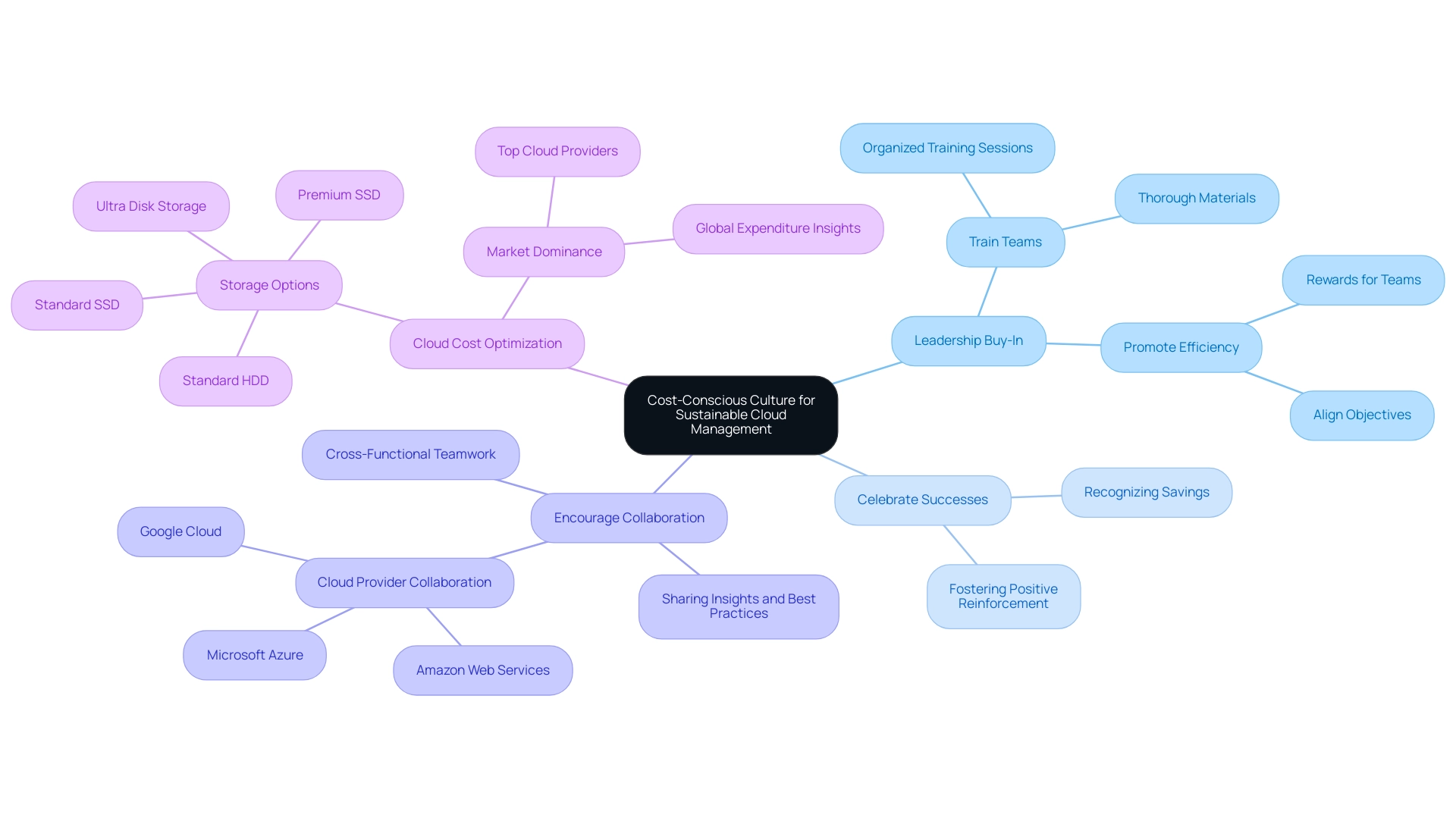
Conclusion
Effective cloud cost optimization is not merely a financial strategy; it is a critical component for any organization aiming to thrive in today’s data-driven environment. Through a comprehensive understanding of cloud usage and the intricacies of pricing models, businesses can identify key cost drivers and implement targeted measures to enhance their resource allocation. By embracing cloud cost optimization, organizations can achieve significant cost savings, improved operational efficiency, and enhanced visibility into their spending.
The benefits of adopting a systematic approach to cloud cost management are manifold. From reducing unnecessary expenses to better resource allocation and scalability, these practices enable organizations to align their cloud investments with strategic business objectives. Moreover, fostering a culture of financial accountability, supported by leadership and ongoing education, can empower teams to make informed decisions that ultimately lead to sustainable growth.
However, organizations must remain vigilant in navigating the challenges that accompany cloud cost optimization. Complex pricing models, lack of visibility, and cultural resistance can hinder progress if not addressed proactively. By prioritizing best practices such as:
- Regular monitoring
- Budget setting
- Resource tagging
companies can overcome these hurdles and ensure that their cloud expenditures contribute positively to their bottom line.
In conclusion, the pursuit of effective cloud cost optimization is essential for organizations seeking to harness the full potential of cloud technologies. As the landscape continues to evolve, adopting a strategic and collaborative approach will not only mitigate costs but also position businesses for long-term success and innovation. Embracing these principles will create a resilient infrastructure capable of adapting to the dynamic demands of the market while maximizing the value derived from cloud investments.




